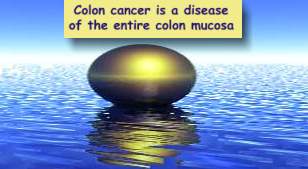The Cancer Journal - Volume 6, Number 6 (November-December 1993)
editorial
Does colon cancer arise as such, or is it the outcome of repeated genome alterations manifested by well defined histomorphological changes, known as the "Polyp-cancer sequence"? (1,2). The two hypotheses have important therapeutical consequences. If a cell turns into a carcinoma in one step, treatment indication is simple and straightforward: "Remove upon detection". On the other hand, if neoplasia progresses in steps, how to deal with "pre-neoplastic" lesions, e.g., adenomatous polyp? (3). Adenomatous polyps smaller than 5 mm never become malignant, and the risk of a malignancy in a 2 cm polyp is 0.014 (4). Should we screen for these benign lesions and remove them? It is estimated that 725,000 people in the US have at least one adenomatous polyp, and about 300,000 have two or more.
If neoplasia evolves, as postulated by the second theory, we have to specify what to remove and when, which is not at all simple, since removal of pre-malignant lesions may be more dangerous to the patient than leaving them behind. Which illustrates the main drawback of screening for adenomatous polyps. The higher the polyp yield, the lower the risk of getting cancer. On the other hand the higher the yield the greater the chances of iatrogenic complications. Apparently the development of adenomas precedes that of carcinomas by five to ten years (1). Even in familial polyposis syndromes the appearance of benign adenomas antedates the development of carcinoma by 10 to 12 years. The decision when to remove a "pre-neoplastic" lesion may be even more difficult.
Some believe that neoplasia evolves within a diseased mucosa. According to the "bad soil" hypothesis "the colonic mucosa of patients with polyps is, in some way, predisposed to growing both benign and malignant neoplasms. The normal-appearing portion of mucosa of individuals who have neoplasms contains higher levels of tyrosine kinase and ornithine decarboxylase than does the normal mucosa of those who do not have such growths" (4). In other words, the polyps are just indicators of a generalized mucosal pathology. Experimental carcinogenesis corroborates the "bad soil" hypothesis. The colonic mucosa is made up of crypt units paved by epithelial cells. Progenitor cells located in the crypt interior proliferate and their progeny stream toward the crypt orifice. When entering the upper third of the crypt, progenitors lose their capacity to divide, differentiate and become maturing end-cells. The average life span of a crypt cell is 36 hours (5).
Repeated injections of the carcinogen 1,2 dimethylhydrazine (DMH) induce colon cancer in all treated rats (5). There is one morphological characteristic which appears very early in the treatment, long before dysplasia and adenomatous polyp. Crypt progenitors fail to mature and accumulate in the upper third of the crypt. This phenomenon, known as "maturation arrest" affects the mucosa of normal appearance and can be detected only after labeling the cells with tritiated thymidine. Autoradiograms of labeled crypts treated with DMH reveal that progenitors occupy nearly the entire crypt (5-7). While in the healthy crypt the ratio of progenitors to end-cells is about 2/1, following carcinogen treatment the progenitors become more and more abundant. The ratio rises to 5/1, 10/1 until the virtual disappearance of maturing end-cells. The rising ratio indicates that more and more progenitors fail to mature and die as such. "Maturation arrest" is the first manifestation observed after DMH treatment, when the mucosa appears normal, only the relative ratio between progenitors and end-cells rises. It is manifested in all pre-neoplastic lesions as well as in colon carcinoma. DMH treatment thus induces a generalized mucosal disease manifested by "maturation arrest" which ultimately evolves into carcinoma. It is a metabolic disease of the mucosa, here called colosis.
It is proposed here that colon cancer starts as colosis which evolves with time into carcinoma. It is a disease of the entire colonic mucosa. In order to understand it we should distinguish between manifestations that are attributable to the carcinogen itself and protective measures mobilized by the affected organ (8). DMH is a poison which triggers protective strategies in the organism. The manifestations observed during the polyp-cancer sequence might be essentially protective, created for detoxifying carcinogens or their adducts. As long as they do not impose any immediate threat or inconvenience to the patient they should be left intact, and removed only if causing secondary undesired complications, e.g., bleeding or bowel obstruction (9).
G. Zajicek
1. Boland CR, Itzkowitz SH, Kim YG. Colonic polyps and the gastrointestinal polyposis syndromes. In: Gastrointestinal disease. Sleisenger MH and Fordtran JS eds. WB Saunders Co, Philadelphia, pp 1483-1497, 1989.
2. Boone CW, Kellhoff GJ, Steele VE. Natural history of intraepithelial neoplasia in humans with implications for cancer chemoprevention. Cancer Res 52, 1651-1659, 1992.
3. Simon JB. Colonic polyps, cancer and fecal occult blood. Ann Int Med 118, 71-72, 1993.
4. Koretz RL. Malignant polyps: are they sheep in wolves clothing? Ann Int Med 118, 63-68, 1993.
5. Wright N, Alison M. The biology of epithelial cell populations, vols.1,2, Clarendon Press Oxford, 1984.
6. Maskins AP. Mechanisms of adenoma formation in the colon. In: Frontiers in Gastrointestinal cancer. Level and Ruddel eds, Elsevier NY, 249-259, 1984.
7. Lipkin M. Phase-1 and phase 2 proliferative lesions of colonic epithelial cells in diseases leading to colonic cancer. Cancer 34, 878-888, 1974.
8. Zajicek G. What is a disease? The Cancer J 4, 296, 1992.
9. Zajicek G. Hypothesis: cancer is a metabolic deficiency. The Cancer J 4, 356, 1992.

